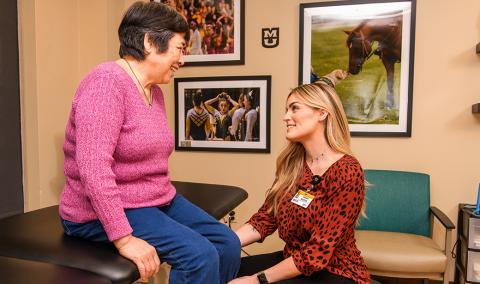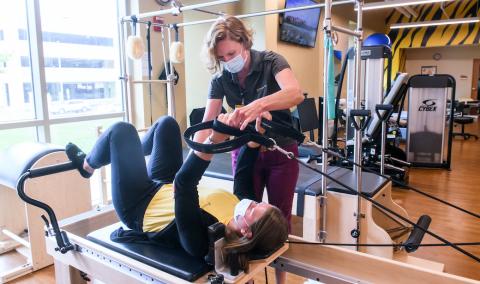At MU Health Care, our women’s health and child health experts know every pregnancy is a team effort. Whether you had a vaginal delivery or a cesarean section, an uncomplicated birth or one that needed extra care, your body has had to deal with a lot. It can be very hard in the postpartum period to know what things are normal and what might be the sign of a problem.
The postpartum period will include a lot of adjustments as you welcome and take care of the newest member of your family. And although it’s natural to want to center your focus and attention around your baby’s needs, it’s important to remember to take care of yourself as well. As part of your care team, we want to ensure you have everything you need for a healthy postpartum recovery.
Why do I need physical therapy postpartum?
The physical strains of pregnancy and childbirth can sometimes injure your pelvic floor and abdominal muscles. A physical therapy evaluation by a pelvic health therapist can determine any issues that should be addressed.
Your body goes through many changes during pregnancy, often leading to muscles that are stretched and weak after childbirth. Even if you have had kids before, going back to caring for a newborn 24/7 can be quite the challenge — it’s like a workout that you can’t work your way up to. This can lead to some aches and pains. Some of these will go away as your body gets stronger, some can be avoided with careful attention to your body movements, and some may lead to much larger issues if not properly addressed.
Postpartum pelvic dysfunction symptoms
In general, a referral to for postpartum physical therapy with one of our pelvic health specialists is recommended if you experience any of the following:
- Instrument-assisted delivery (forceps, vacuum)
- C-section delivery
- Perineal tearing, especially second- to fourth-degree tears, or episiotomy
- Baby with shoulder dystocia during delivery
- Long or short pushing phase
- Vaginal or perineal soreness that lasts more than two weeks
- Pain in neck, back, hips or legs that lasts more than two weeks
- Pelvic girdle instability or asymmetry
- Diastasis recti separation or DRAM
- Pubic symphysis pain
- “Falling out” feeling that doesn’t resolve within two weeks
- Pelvic pain or painful sex
- Urinary or bowel frequency, urgency or leakage
- Constipation
- Pain or difficulty with bowel movements
None of these symptoms are considered normal. If you experience any of these things for more than six weeks postpartum, let your postpartum care team know so they can refer you to our pelvic health specialists. Mizzou Therapy Services has seven area locations to provide convenient be assessed by one of our specially trained pelvic health therapists.
Abdominal muscle separation
During pregnancy your abdominal muscles stretch to accommodate your growing uterus and baby. As a result, diastasis rectus abdominus muscles (DRAM) may occur, which results in the muscles feeling weaker than they did prior to pregnancy. This change is normal and expected with a full-term pregnancy. For some, the muscles do not automatically come back together after delivery, contributing to low back pain, core weakness and a looser appearance of the abdominal area.
After delivery and prior to starting any exercise program, we recommend you self-test to assess separation using the following steps. If you had a C-section, you should wait at least five weeks before a self-assessment.
- Lie on your back and put both feet flat on the floor, bending your knees to get into a comfortable
- Lift your head and neck slightly so you can see your stomach
- Place your fingers just above your belly button and feel for a gap in your muscles, then do the same below your belly button
- Turn your fingers toward your toes to measure the gap
If the width of two or more fingers fit in the gap, you can wear a compression garment for the first eight weeks after birth and practice correct posture. When cleared by your doctor, crunches and Russian twist exercises can also help you regain core strength and resolve DRAM.
Recovering from C-section
A C-section is a major abdominal surgery, and it is important to allow your body time to fully heal. Pushing your body too hard after a C-section can lead to increased internal scar tissue formation, which can cause problems with pain, and bladder and bowel function in the future.
You can begin some gentle stretching and self-massage techniques once your incision is healed and you feel your body is ready.
Postpartum return to activity and exercise
After pregnancy, your body may feel different than it did before. For some, this be uncomfortable. The first thing to remember about in your postpartum journey is that your body accomplished a huge task by growing and birthing a child. Things may feel different, look different or move different, but you can heal fully and get back to the activities you were doing prior to your pregnancy.
Our physical therapists and pelvic health specialists recognize exercise can be difficult, whether its finding the right program for you or working it into your schedule.
Early postpartum period (0-3 weeks)
Early post-partum exercise routines benefit from deep breathing, gentle core activation exercises and gentle stretching. These exercises are safe to begin whenever you feel ready after delivery, but if your bleeding or pain increases, that could be a sign you should rest more.
Kegels or pelvic floor contractions are a good way to strengthen your pelvic floor after childbirth and to improve support of your pelvic organs. Kegels are not appropriate for every person. If you perform Kegels and you begin to have any discomfort in and around the perineum, changes in bowel or bladder functions, or you can’t feel your muscles contracting and relaxing fully, they may not be right for you at this time. We suggest meeting with a pelvic health physical therapist to help you plan your recovery.
When you Kegel correctly, your gluteal, groin and abdominal muscles should not be contracting with your pelvic floor. If you’re near other people, they should not notice that you’re doing anything. Full relaxation is essential for correct pelvic floor relaxation, so take your time contracting your pelvic floor and don’t rush through sets. Begin with a set of 10 a few times a day and gradually increase how many sets you do in one sitting as you gets stronger and have more control.
Functional exercise progression (3-6 weeks)
Most women can safely start functional strengthening exercises withing a few weeks of delivery. Some may be ready by week 3 or 4, some women may need longer to feel comfortable enough to progress. Remember to eat plenty to fuel your body for healing and the extra caloric needs from exercise, especially if you breastfeed. Consider talking to a lactation consultant if you have concerns about your milk supply with exercise.
For advanced workouts, we recommend a consultation with one of our pelvic health specialists or exercise physiologists to customize a plan that safely meets your personal and fitness goals while allowing your body to heal. In general, you should wait 6-8 weeks before returning to any type of impact exercise (running, jumping, fast walking, aerobics, HIIT, etc.). This is because your uterus is shrinking back down and returning to its normal position in your pelvic cavity and your pelvic floor is recovering, so it is not yet ready to handle repeated impact.
Sex after childbirth
Most practitioners recommend waiting until after your six-week appointment to start having sex again. If your doctor has cleared you before that, it is certainly fine to start it earlier. The most important thing to know is that postpartum sex should not hurt. There are many things that can happen during pregnancy, labor and delivery that can lead to painful sex, but these are not considered normal and can usually be treated successfully.
If you have attempted to return to intercourse without success, a pelvic health therapist should evaluate your pelvic floor to check for scar tissue, muscle spasms or other problems that may be causing difficulties or pain when attempting to have sex.
Related Conditions & Treatments
- Aquatic Therapy
- Blood Flow Restriction Therapy
- Cancer Rehabilitation
- Children's Therapy
- COVID Recovery Program
- Pediatric Inpatient Rehabilitation
- Pediatric Pelvic Floor Therapy
- Neurological Rehabilitation
- Occupational Therapy
- Pelvic Pain and Dysfunction
- Physical Therapy
- Postpartum Therapy
- Specialized Therapy
- Speech Therapy
- Sports Therapy



























